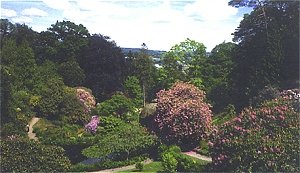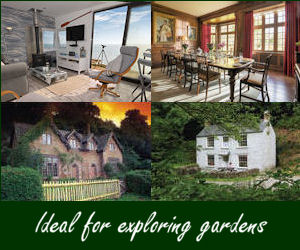Cotehele
| Contact | Toby Fox |
| Enquiries | 01579 351346 |
| Fax | 01579 351222 |
| cotehele@nationaltrust.org.uk | |
| Website | www.nationaltrust.org.uk/cotehele |
| A large mature garden (with some steep paths), daffodil meadow, unusual trees, small Acers. Formal terraced garden with magnolias and climbers. | |
| Open | Garden All year 7 days a week 10:30 - dusk House 13th Mar - 31st Oct Sat-Thu, 11.00 - 16.30 |
| Admission | House, Gardens & Mill: Adults: £9.60, Children: £4.80 Family: £24.00, Garden & Mill Only: Adults £5.80, Children: £2.90 Family £14.50 |
Cotehele is a Tudor house located in St Dominick, near Saltash on the west bank of the River Tamar. The Edgcumbe family acquired Cotehele through marriage in 1353. William Edgcumbe married Hilaria de Cotehele the sister of Ralph de Cotehele who inherited if from their father William de Cotehele. The original house was a quadrangular building of red sandstone, which still forms the lowest levels of walls surrounding the inner courtyard.
The original medieval manor house was rebuilt between 1490 and 1520 by Sir Richard Edgcumbe and his son, Piers. They followed the original plan of the house, improving and enlarging the facilities using local granite, sandstone and slate. In 1547 Piers started the building of the house at Mount Edgcumbe and in 1553 the family moved to Mount Edgcumbe, 10 miles to the south (24 miles by road), with Cotehele only occasionally being occupied ever since and as a result it has remained one of the least altered great medieval houses in England, even today there are is no electric light. The family always appreciated the historical value of Cotehele and kept it for its own use rather than let it as a tenanted farmhouse.
A tower was added in 1627, which added three impressive bedrooms to the facilities at Cotehele. King Charles I is said to have stayed the night here. Cotehele remained with the Edgcumbe family until 1947 when it was accepted by the Treasury in payment of death duties of the 6th Earl and given to the National Trust. The trust then embarked on a period of restoration which was completed in 1958. Most of the original furnishings and tapestries remain at the house on loan from Lord Mount Edgcumbe's trustees.
Entry is via the Great Hall which has an impressive display of arms and armoury, set amongst a collection of period furniture, textiles and verdure tapestries under a high arched timber roof. There are three internal courtyards, and of particular note is the a very rare chapel clock installed in 1489 and powered by two 90 pound weights.
Cotehele House is surrounded by both formal and natural gardens, ranging from flower beds to extensive woodland, including remnants of the original two deer parks. The House stands at the head of a valley garden descending steeply to the River Tamar. The Gardens in their present form were laid out by the Edgcumbe family during the 19th century. Since acquiring the gardens the Trust has developed the gardens considerably with gentle restoration and renewal. There are walled gardens, ancient orchards, herbaceous borders, valley gardens, ponds, terraces and formal courtyards.
The house itself has been surrounded with climbing plants such as wisteria and roses, it faces The Bowling Green, a lawn area lined with sycamores trees. To the east there are broad Victorian terraces on three levels, featuring many old plants and some more recent magnolias, while the beds beneath have wall flowers and roses. Relatively close to the house, in the upper garden is a lily pond and an orchard. This area of Cornwall was once renowned for its fruit including cherries and plums as well as the more ordinary apples and pears.
The path down the through terraces leads into a wooded valley where the domed 15th century dovecote and a thatched Victorian summerhouse can be found. The camellias, rhododendrons and azaleas which thrive in this ancient woodland are kept damp by a small stream. The gardens are renowned for the old oaks, both individual yews and yew hedges as well as Spanish chestnut trees. Unfortunately many of the most notable trees were lost in severe gales in 1891. Lower down is a further valley, much more densely wooded but interspersed with clearings and pools surrounded by shrubs. Eventually the path leads into Cotehele Wood, overlooking the river. The wood contains a wide selection of species of trees.
The Estate has many miles of footpaths by the river Tamar and through woodlands. A short walk through the gardens and along the river leads to The Cotehele Quay, which was busy in during in the 19th century. The Cotehele Quay has remained largely unaltered since the 19th Century and contains tea rooms, an art and craft gallery and the Quay Museum. The Quay Museum established by the National Maritime Museum gives a good insight into trade on the river and the coasts of South Devon and Cornwall, as well as of the mining, quarrying and shipbuilding industries of the Tamar Valley.
The “Shamrock”, a restored Tamar sailing barge is moored alongside the Quay Museum when not making occasional voyages on the River Tamar. Built in 1899 (57ft) carried various cargoes on the river and worked as a diving tender and salvage barge before being acquired by The National Trust in 1974. It is now jointly owned by the National Maritime Museum who supervised her full restoration to sea-going condition.
A further walk along the woodland leads to Cotehele Watermill a restored late eighteenth century working water mill. Commercial operations ceased in 1964 but the national Trust has restored the mill to working order milling flour on certain days which may be purchased.
There are also further industrial ruins in the Danescombe valley including the remains of Danscombe Valley Mine, marketing gardening, old walled gardens and packing sheds. The area was an important copper and arsenic mining area though in the Danescombe valley, the mine was no longer working by 1868 apart from a brief revival in the 1890s.



